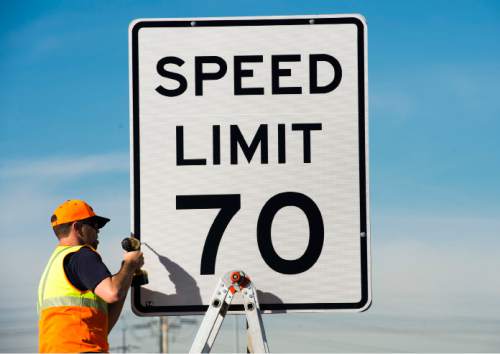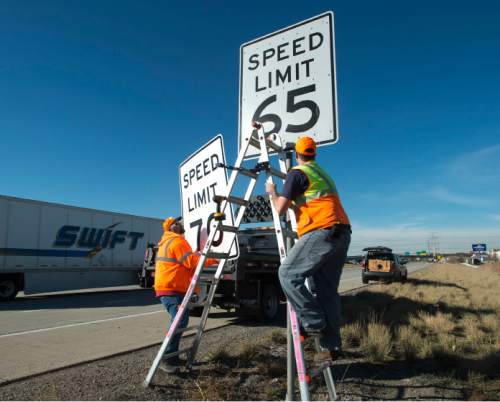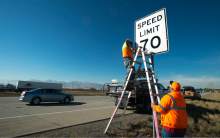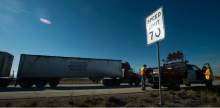This is an archived article that was published on sltrib.com in 2015, and information in the article may be outdated. It is provided only for personal research purposes and may not be reprinted.
Raising the speed limit to 70 mph on Utah's urban freeways has brought only small changes in how fast drivers actually go.
Average speeds increased by up to 2 mph in some sections, but surprisingly dropped 2 mph in others since the change in December, according to data released Tuesday by the Utah Department of Transportation.
"It's really in line with our expectations," said UDOT spokesman John Gleason. "A vast majority of the traveling public was already driving at 70 mph or even more," even though the speed limit previously was 65 mph.
"Most people drive at the speeds where they are comfortable," Gleason said. So boosting the limit did not change habits much — but legalized the higher speed that many already were traveling.
What UDOT intended with the higher limit, he added, was to make speeds more uniform. "Speed differentials cause crashes. Someone going much slower or faster than the majority of drivers is dangerous."
Gleason noted that UDOT found similar results when it upped freeway speed limits in many rural areas from 65 to 80 mph. Studies found average speeds there also increased only 1 to 2 mph.
"It really speaks to the fact that people are traveling at the speeds that they are comfortable at," Gleason said. "We want to make the posted speed limit realistic."
UDOT normally would collect speed statistics for several years before providing them, Gleason noted. But the agency released data for January through March because of high interest and an unusually mild winter, which resulted in speeds viewed as closer than usual to the annual norm.
Some insurance groups — and, initially, the Utah Highway Patrol — had criticized the higher limit, worrying it would lead to more unsafe speeding.
Because this year's tame winter, with little snow and ice, created near-normal driving conditions, "we expect this [speed] information to be consistent going forward," Gleason said. "But we will continue to monitor speeds."
Some sections where speeds increased the most — 2 mph more than last June — included Interstate 15 in Davis County, Interstate 215 eastbound in Murray and Interstate 80 westbound in Salt Lake City.
Sections where average speeds dropped were I-15 in Draper, down by 2 mph, and I-15 northbound near Ogden and I-215 southbound in Salt Lake City, where they dipped by 1 mph. Gleason said those decreases are expected to rise and even out over time.
While average speeds may not have changed much, they often remain well above the current 70 mph — and frequently over 75 mph — but they were as high before the raised limit.
Average speeds are over 75 mph in stretches including southbound I-15 in Lehi, northbound I-215 in Holladay, northbound I-215 in Taylorsville and West Valley City, and northbound I-15 in Salt Lake City and Davis County.
When the speed limit went up, UHP warned that troopers would strictly enforce it — and especially target any vehicles going faster than 75 mph.
Changes in state law last year allowed UDOT to raise speed limits up to 80 mph on interstate freeways wherever the agency deems them safe. Gleason said UDOT examined existing speeds, accident rates and road designs to figure that 70 mph was safe on most urban freeways.
He said the agency has no plans to increase limits on other interstate sections.
UDOT told the Utah Transportation Commission last month that while highway deaths have jumped by 37 percent so far this year, it does not blame that on the new 70 mph speed limits.
Jason Davis, UDOT chief of operations, said the agency found that only four of the 256 road fatalities at that time had occurred on roads with limits of 70 mph or higher.
More fatalities — six — occurred on roads posted at 25 mph or less. He said the largest percentage of fatal crashes happen on roads with a 40 mph speed limit.
Davis said the biggest reason that fatalities are up is that many Utah motorists do not wear seat belts. About 60 percent of the people killed this year were not properly restrained.
A new law making it easier to buckle down on motorists who don't buckle up takes effect Tuesday. It makes not wearing a seat belt a "primary offense," meaning officers can stop and cite people directly for the lapse.
Utah has a "secondary" law for those 18 an older, allowing a ticket only when an officer stops a vehicle for another reason.









